Microbial
Processes > Long-Term Soil Productivity (LTSP) Study > Tour: 4 - Post-Harvest Measurements
Post-Harvest Measurements
Soil Measurements
- Soil erosion (soil cover, % surface disturbance water stable aggregates, soil depth change)
- Water availability (potential infiltration, saturated hydrolic conductivity, AWC, soil moisture at critical periods)
- Nutrient availability (soil cover, OM%, soil color)
- Root growth and uptake (including bulk density, soil strength, soil porosity, soil structure)
Vegetative Data
- Planted trees measured (1st, 3rd, and 5th years and at 5 year intervals after that)
- Other vegetation measured (height and %)
- Cumulative standing biomass and leaf surface areas estimated (5 year intervals for all vegetation)
- Plant damage
- Dry weight and nutrient content of current and year-old upper crown foliage and perennial understory vegetation
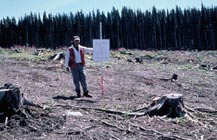 C0OM2 treatment one year after harvest. (LTSP site, British Columbia, Canada - Note: Canadian scientists use a different numbering system for treatments so signs in photos do not correspond to U.S. treatment numbers)
C0OM2 treatment one year after harvest. (LTSP site, British Columbia, Canada - Note: Canadian scientists use a different numbering system for treatments so signs in photos do not correspond to U.S. treatment numbers)
[view medium photo - 124K]
[view large photo - 232K]
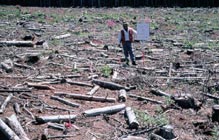 C1OM0 treatment one year after harvest. (LTSP site, British Columbia, Canada - Note: Canadian scientists use a different numbering system for treatments so signs in photos do not correspond to U.S. treatment numbers)
C1OM0 treatment one year after harvest. (LTSP site, British Columbia, Canada - Note: Canadian scientists use a different numbering system for treatments so signs in photos do not correspond to U.S. treatment numbers)
[view medium photo - 148K]
[view large photo - 276K]
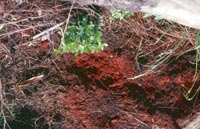 Wood becoming part of the soil.
Wood becoming part of the soil.
[view medium photo - 88K]
[view large photo - 140K]
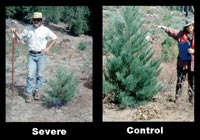 Trees planted in the plot treated with severe compaction (C2) grew to be much smaller the trees planted in the control group (LTSP site in California).
Trees planted in the plot treated with severe compaction (C2) grew to be much smaller the trees planted in the control group (LTSP site in California).
[view medium photo - 88K]
[view large photo - 124K]
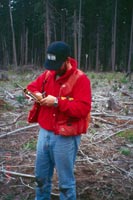 Preparing CO2 soil samples.
Preparing CO2 soil samples.
[view medium photo - 56K]
[view large photo - 84K]
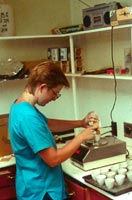 Preparing samples at the lab.
Preparing samples at the lab.
[view medium photo - 52K]
[view large photo - 80K]
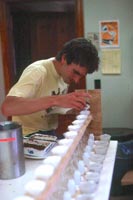 Extracting samples in the lab.
Extracting samples in the lab.
[view medium photo - 36K]
[view large photo - 48K]
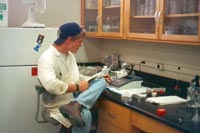 Forest Service technician conducting soil tests in the lab.
Forest Service technician conducting soil tests in the lab.
[view medium photo - 40K]
[view large photo - 52K]
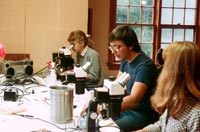 Forest Service personnel counting micorrhizae at the lab.
Forest Service personnel counting micorrhizae at the lab.
[view medium photo - 56K]
[view large photo - 88K]
Next Page - Climate Measurements >










